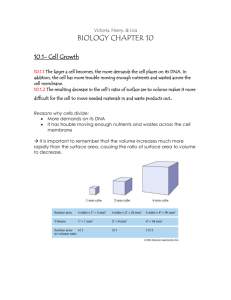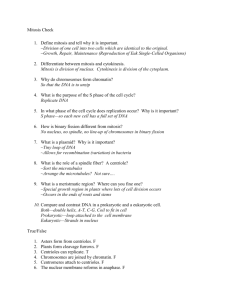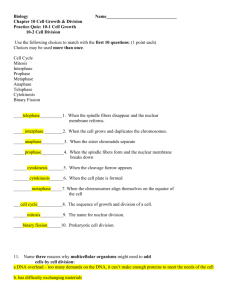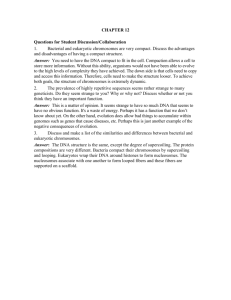Chapter 10 Cell Grwt 15
advertisement
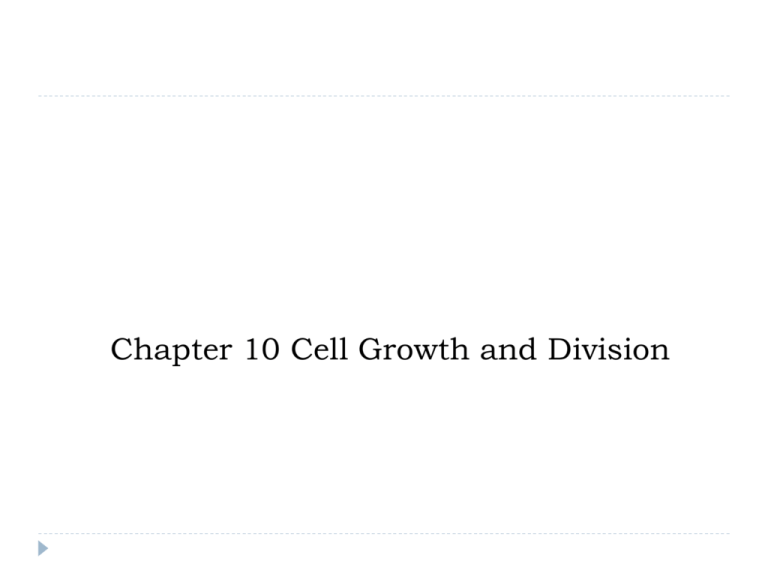
Chapter 10 Cell Growth and Division Bellringer (on PP 227) Why do cells need to reproduce? Cells need to reproduce so that an organism can function efficiently (remember the surface area to volume ratio limitations for cell size) and replace damaged tissue (eukaryotes only) Bellringer on PP 178 At what point is a cell committed to division? After S phase of interphase. Once DNA is replicated the cell MUST divide or die. Bellringer on PP 205 Name the states of condensation of DNA in order from least condensed to most condensed. Why is this important for cell division? Chromatin, nucleosome, chromatid, chromosome. This is necessary so that during division, the DNA does not get tangled and damaged REPRODUCTION- Because larger cells are more difficult to maintain, cells divide when they grow to a certain size. The size of an organism does not increase by increasing cell size but by increasing the number of cells. REPRODUCTION New cells are needed to help tissues and organs grow. New cells also replace damaged cells. As old cells die and new cells take their place. REPRODUCTION A cell’s ability to exchange substances is limited by its surface area–to-volume ratio. As a cell gets larger, substances must travel farther to reach where they are needed. REPRODUCTION The work of cells is done by proteins. As a cell gets larger, more proteins are required to maintain its function. REPRODUCTION If the cell gets too large, DNA instructions cannot be copied quickly enough to make the proteins that the cell needs to support itself. CHROMOSOMES CHROMOSOMES -chromosomes are the condensed DNA of the cell. The way DNA is stored and read differs between eukaryotes and prokaryotes. Diagram of winding with histones from book CHROMOSOMES PROKARYOTES- Prokaryotic chromosomes also have genes which code for proteins and RNA for the prokaryotic cell functions. A prokaryotic cell has a single circular molecule of DNA. This loop of DNA contains thousands of genes. A prokaryotic chromosome is condensed through repeated twisting or winding, like a rubber band twisted many times. PROKARYOTES CHROMOSOMES EUKARYOTES- Eukaryotic DNA is packaged into highly condensed chromosome structures to fit in the nucleus with the help of many proteins. CHROMOSOMES The large molecule of DNA is organized into hereditary units called genes. A gene is a segment of DNA that codes for the RNA and proteins of a particular trait (ex hair color). The DNA and proteins make up a substance called chromatin. The first level of packaging is done by a class of proteins called histones. A group of eight histones come together to form a disc-shaped histone core. DNA COILING AROUND HISTONES CHROMOSOMES The long DNA molecule is wound around a series of histone cores in a regular manner and is called a nucleosome. The string of nucleosomes lines up in a spiral to form a cord that is 30 nm in diameter. During most of a cell’s life, its chromosomes exist as nucleosomes. CHROMOSOMES As the cell prepares to divide, the chromosomes condense even further ensuring that the extremely long DNA molecules do not get tangled up during cell division. The nucleosome cord forms loops then coil into the final, most highly condensed form of the chromosome. CHROMOSOMES Each of the two thick strands of a fully condensed, duplicated chromosome is called a chromatid. Each chromatid is made of a single, long molecule of DNA. Identical pairs, called sister chromatids, are held together at a region called the centromere. CHROMOSOMES During cell division, the sister chromatids are separated at the centromere, and one ends up in each daughter cell. Each new cell has the same genetic information as the parent cell. PREPARING FOR CELL DIVISION PREPARING FOR CELL DIVISION- The process of cell division involves more than cutting a cell into two pieces. Each new cell must have all of the equipment needed to stay alive. Each new cell will function in the same way as the cells that they replace. http://my.hrw.com/sh2/sh07_10/student/flash/concept_ma ps/hx8_crp_cm.htm PREPARING FOR CELL DIVISION Prokaryotes-prokaryotic cell division is more simple than eukaryotic division In prokaryotic cells, the circular DNA molecule is attached to the inner cell membrane. The cytoplasm is divided when a new cell membrane forms between the two DNA copies. Meanwhile the cell continues to grow until it nearly doubles in size. PREPARING FOR CELL DIVISION The cell is constricted in the middle, like a long balloon being squeezed near the center. Eventually the dividing prokaryote is pinched into two independent daughter cells, each of which has its own circular DNA molecule. PREPARING FOR CELL DIVISION Eukaryotes Eukaryotic cells have many organelles. In order to form two living cells, each daughter cell must contain enough of each organelle to carry out its functions. The DNA within the nucleus must also be copied, sorted, and separated. EUKARYOTIC CELL CYCLE EUKARYOTIC CELL CYCLE -The life of a eukaryotic cell cycles through phases of growth, DNA replication, preparation for cell division, and division of the nucleus and cytoplasm. The cell cycle is a repeating sequence of cellular growth and division during the life of a cell. The cell cycle is made up of five phases. The first three phases together are known as interphase. The remaining two phases make up cell division. EUKARYOTIC CELL CYCLE INTERPHASE G1- During the first gap phase (G1), a cell grows rapidly as it builds more organelles. For most organisms, this phase occupies the major portion of the cell’s life. EUKARYOTIC CELL CYCLE INTERPHASE S-During the synthesis phase (S), a cell’s DNA is copied. At the end of the S phase, the cell’s nucleus has twice as much DNA as it did in the G1 phase. EUKARYOTIC CELL CYCLE INTERPHASE G2-During the second gap phase (G2), the cell continues to grow and prepares to divide. Hollow protein fibers called microtubules are organized in the cytoplasm during G2. EUKARYOTIC CELL CYCLE - MITOSIS STAGES OF MITOSIS - Mitosis is a continuous process that can be observed in four stages: prophase, metaphase, anaphase, and telophase. EUKARYOTIC - MITOSIS- PROPHASE Stage 1: Prophase Within the nucleus, chromosomes begin to condense The nuclear membrane breaks down. Outside the nucleus, a special structure called the spindle forms. The spindle is made up of several spindle fibers. EUKARYOTIC - MITOSIS- PROPHASE Stage 1: Prophase The nuclear membrane breaks down. Outside the nucleus, a special structure called the spindle forms. The spindle is made up of several spindle fibers. EUKARYOTIC - MITOSIS- PROPHASE Cells have an organelle called the centrosome, which helps assemble the spindle EUKARYOTIC - MITOSIS- PROPHASE In animal cells, the centrosome includes a pair of centrioles. Before mitosis, the cell’s centrosome is duplicated. During prophase, the centrosomes move to opposite poles of the cell. EUKARYOTIC - MITOSIS- METAPHASE Stage 2: Metaphase During metaphase, the chromosomes are packaged into their most condensed form. EUKARYOTIC - MITOSIS- METAPHASE The nuclear membrane is fully dissolved, and the condensed chromosomes move to the center of the cell and line up along the cell’s equator. EUKARYOTIC - MITOSIS- METAPHASE Spindle fibers form a link between the poles and the centromere of each chromosome. EUKARYOTIC - MITOSIS- ANAPHASE Stage 3: Anaphase Once all of the chromosomes are lined up, the spindle fibers shorten. The spindle fibers shorten by breaking down the microtubules bit by bit EUKARYOTIC - MITOSIS- ANAPHASE Sister chromatids move toward opposite poles as the spindle fibers that are attached continue to shorten. Each pole now has a full set of chromosomes. EUKARYOTIC - MITOSIS- TELOPHASE Stage 4:Telophase A nuclear envelope forms around the chromosomes at each pole of the cell. EUKARYOTIC - MITOSIS- TELOPHASE Chromosomes, now at opposite poles, uncoil and change back to their original chromatin form. EUKARYOTIC - MITOSIS- TELOPHASE The spindle dissolves and the spindle fibers break down and disappear EUKARYOTIC - MITOSIS- TELOPHASE Mitosis is complete. EUKARYOTIC - CYTOKINESIS CYTOKINESIS-During cytokinesis, the cell membrane grows into the center of the cell and divides it into two daughter cells of equal size. Each daughter cell has about half of the parent’s cytoplasm and organelles. As mitosis ends, cytokinesis begins. The end result of mitosis and cytokinesis is two genetically identical cells in place of the original cell. EUKARYOTIC - CYTOKINESIS Separating the Cytoplasm In animal cells and other cells that lack cell walls, the cell is pinched in half by a belt of protein threads. In plant cells and other cells that have rigid cell walls, the cytoplasm is divided by a cell plate. CONTROLS CONTROLS-Cell growth and division depend on protein signals and other environmental signals. Cell division is highly controlled. Signals from surrounding cells or even from other organs can also regulate cell growth and division. Environmental conditions, such as availability of nutrients, the amount of light and temperature, also affect the cell cycle. CHECKPOINTS CHECKPOINTS -Feedback signals at key checkpoints in the cell cycle can delay or trigger the next phase of the cell cycle. During the cell cycle, a cell undergoes an inspection process to ensure that the cell is ready for the next phase in the cell cycle.There are three main checkpoints in the cell cycle—G1checkpoint, G2 checkpoint, mitosis checkpoint. CHECKPOINTS G1 checkpoint- Before the cell copies its DNA, the cell checks its surroundings. If conditions are favorable and the cell is healthy and large enough, the cell enters the synthesis phase. If conditions are not favorable, the cell goes into a resting period. Certain cells, such as some nerve and muscle cells, remain in this resting period forever CHECKPOINTS G2 checkpoint- Before mitosis begins, the cell checks for any mistakes in the copied DNA. Enzymes correct any mistakes. This checkpoint ensures that the DNA of the daughter cells will be identical to the DNA of the original cell. If the cell passes the G2 checkpoint, then the cell may begin to divide. Once past this checkpoint, proteins help to trigger mitosis. CHECKPOINTS Mitosis checkpoint- During the metaphase stage of mitosis, chromosomes line up at the equator. At this point, the cell checks that the chromosomes are properly attached to the spindle fibers. Without this checkpoint, the sister chromatids may not separate properly giving one daughter cell too many genes and one not enough CANCER CANCER-cancer is uncontrolled cell growth and division that can result in masses of cells that invade and destroy healthy tissues. Cancer cell reproduction continues without the normal feedbacks. The defective cell divides and produces more defective cells. Eventually, these cells form a mass called a tumor. CANCER- DEVELOPMENT A benign tumor does not spread to other parts of the body and can often be removed by surgery. A malignant tumor invades and destroys nearby healthy tissues and organs. Malignant tumors, or cancers, can break loose from their tissue of origin and grow throughout the body. This process is called metastasis. Once a cancer has metastasized, it becomes difficult to treat. CANCER- TREATMENT Treatment Some cancers can be treated by using drugs that kill the fast-growing cancer cells. Because drugs are chemicals, this method of treatment is called chemotherapy, or “chemo” for short. Some cancers can be treated by surgery to remove of the affected organ. In radiation therapy, high-energy rays are focused on an area in order to destroy cancerous cells. CANCER- TREATMENT Usually, when cancer has metastasized, prognosis (the likelihood of survival) is poor. CANCER PREVENTION The best way to prevent cancer is to avoid things that can cause cancer (carcinogens) Ultraviolet radiation in sunlight can damage genes that control the cell cycle (skin cancer) Chemicals in cigarette smoke also affect how cell growth and division is regulated. CANCER PREVENTION Large amounts of alcohol consumption have been linked to liver cancers Teenage exposure cell phones has been linked to brain cancer (NOT A JOKE) CANCER PREVENTION Teenage exposure cell phones has been linked to brain cancer (NOT A JOKE) Ch 10 SEC 1 HW 1. As a cell gets larger, it needs more nutrients. Nutrients enter a cell through the cell membrane. However, as a cell gets larger, it becomes more difficult for enough nutrients to enter the cell. If a cell gets too large, nutrients cannot enter quickly enough for the cell to survive. 2. from left to right: chromatin; nucleosomes; DNA (top); histones (bottom) 3. DNA is replicated, and chromosomes begin to condense. Ch 10 SEC 2 HW 1. The cell grows and produces new organelles. 2. mitosis and cytokinesis 3. Spindles connect the centromeres of sister chromatids to opposite sides of the cell during metaphase. During anaphase, the spindles shorten, separating the sister chromatids. 4. top row: Anaphase second row: Prophase third row: Telophase bottom row: Metaphase Ch 10 SEC 2 HW 5. In animal cells, protein fibers pull the cell membrane together and cause it to pinch off, forming two new cells. In plant cells, a cell plate made of cell wall material forms in the center of the cell, then slowly grows outward until it splits the cell in two. Ch 10 SEC 3 HW 1. Cancer occurs when a cell divides uncontrollably. This generally occurs because the cell stops responding to signals that regulate its movement through the cell cycle. 2. within the cell, nearby cells, or the environment 3. At the G1 checkpoint, the cell checks that its environment is favorable for replication and makes sure that it is healthy. At the G2 checkpoint, the cell checks that its DNA has been copied correctly and that it is large enough to divide. At the metaphase checkpoint, the cell checks that genetic material has been correctly distributed between the daughter cells. Ch 10 SEC 3 HW 4. They tell the cell whether or not to move on to the next phase in the cell cycle. 5. Benign tumors generally do not spread to other parts of the body, and most can be removed by surgery. Malignant tumors invade nearby healthy tissue and can break off and travel to other parts of the body. Malignant tumors are generally harder to treat than benign tumors. 6. Possible answers: cigarette smoke, benzene, ultraviolet rays MITOSIS MOVIE http://glencoe.mcgrawhill.com/sites/dl/free/0078786789/164155/00053413.html

